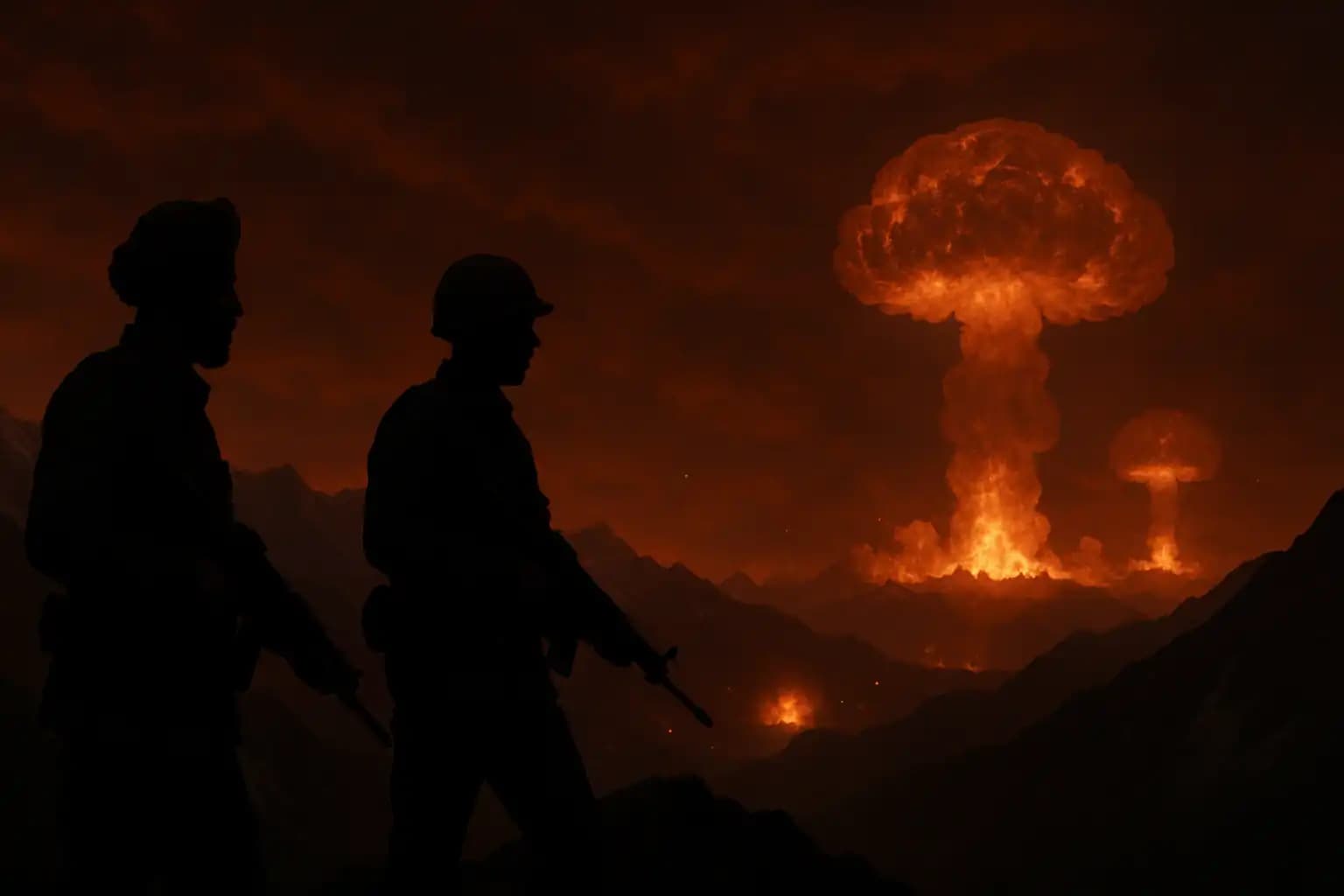The pre-monsoon heat above Kashmir rises in shimmering waves, but the real temperature spike is geopolitical. India’s precision-guided “Operation Sindoor” strikes have vaporized supposed militant camps across the Line of Control. Pakistan’s defense minister sounds every inch the doomsday herald, vowing that “either we live, or no one does.” Smartphones from Lahore to Lucknow ping with air-raid alerts. In the lethal theater separating two nations born from one partition, the possibility of mushroom clouds no longer reads like dystopian fiction; it now stalks daily headlines.
Independent war correspondent Patrick Lancaster promises “raw frontline footage” of the showdown, but locals have livestreamed tracer rounds over Srinagar’s night sky. Their clips flood Telegram channels that once tracked trench lines in Ukraine, sparking panic on finance desks from Singapore to Frankfurt. As investors refresh risk dashboards, South Asia’s forty-year nuclear taboo teeters on a hashtag.
Operation Sindoor: The Airstrike That Lit the Fuse
New Delhi’s planners labeled the May 6 offensive limited
; Islamabad called it an act of war
. Within hours, satellite imagery analyzed by the Al Jazeera investigations team confirmed nine impact craters. Indian officials say the targets housed Lashkar-e-Taiba facilitators tied to the April massacre of 26 tourists in Pahalgam. Pakistan counters that civilians died in mosques and markets, fueling outrage on both sides of the Radcliffe Line.
Eyewitness accounts sync eerily with reports archived on flashpoint-himalayas-07202024, where earlier warnings mapped potential escalation ladders. Now those ladders look less hypothetical. According to Reuters, Pakistani anti-air systems fired over 60 surface-to-air missiles. One missile may have clipped an Indian Su-30—an incident detailed in real time here: Reuters frontline dispatch. New Delhi denies any airframe loss, but debris images circulating on Pakistani X-feeds suggest otherwise. Each conflicting claim erodes the margin for error.
Doomsday Doctrine: Pakistan’s “Existential” Red Line
Pakistan’s nuclear posture hinges on first-use. This week, Defense Minister Khawaja Asif reminded the world why. In a taped Reuters interview, he declared that if India threatens Pakistan’s existence, “either we both survive, or neither does”—see the full context here: Reuters exclusive. The phrase ricocheted across newsrooms and ignited TikTok commentary faster than analysts could draft rebuttals.
Strategists call this the certainty of uncertainty: Islamabad’s tactical nukes shrink launch decision times to minutes. The policy paper dissected at dead-hand-rising-06222024 argues that such hair-trigger logic mirrors Cold-War Soviet automation schemes. In simple terms, Pakistan’s red line resembles a fog bank; nobody knows where it starts, but everyone fears crashing into it.
India maintains an official no-first-use doctrine, yet wargames discussed in Parliament envision massive retaliation
to any nuclear strike, tactical or otherwise. That paradox—pledging restraint while promising overwhelming response—creates a feedback loop captured in subcontinental-standoff-analysis. Each side believes its policy stabilizes the equation; together, the policies resemble two loaded pistols in a vibrating room.
Frontline Reality: Downed Drones, Fallen Jets, and the Media Fog
As artillery duels light up the Himalayas, digital skirmishes rage online. Pakistani channels claim a dozen Indian drones shot down; Indian officials counter that Pakistani F-7 fighters dropped from radar first. The Guardian’s running blog, the BBC’s live page, and CNN’s mapping kits each present partial views, yet none fully verify battlefield claims amid signal jamming and propaganda. One BBC headline notes Pakistan’s boast about shooting down 25 drones while India speaks of intercepting cruise missiles—the numbers morph hourly.
What remains undeniable is the human toll. Local administrators on the Indian side report 12 civilian deaths from Pakistani shelling; Pakistani health officials list 26 fatalities from Indian strikes. Both figures echo grim assessments in border-blaze-07182024, where casualty projections climbed once air power joined ground skirmishes.
The unresolved fog matters because every contested incident offers political capital. A downed MiG or destroyed hospital becomes a moral cudgel to rally domestic audiences and justify escalation. In 1999, during the Kargil War, television images swayed cabinet meetings; in 2025, livestreams will do the same at 5G speed.
Helplines, Hotlines, and the Thinning Firewall Against Catastrophe
Diplomatic off-ramps exist—on paper. A hotline between India’s DGMOs and Pakistan’s DGMO crackled to life twice after Monday’s barrage, according to sources in both capitals. Yet confidence in that circuit wanes. During the last major crisis in 2019, calls misfired when a snowstorm severed optic cables in Kupwara. This time, cyber-warfare units on each side could deliberately compromise the line, a scenario explored in magnetic-mayhem-07172024, where EMPs and malware target command networks.
International mediators also press buttons. Washington floated offers to host back-channel talks in Oman; Beijing, juggling its own Himalayan standoff with India, signals “neutral facilitation.” United Nations envoys cite Resolution 1172, yet veto politics make Security Council action unlikely. Meanwhile, risk-modelers watch volatility levels spike across Asian sovereign-bond markets—a pattern alarmingly similar to trends documented in seconds-before-midnight-07112024.
Against this backdrop, the statistic that matters is flight time: a Pakistani Babur-III SLBM could hit Mumbai in under ten minutes; India’s Agni-V could retaliate against Karachi five minutes later. Those numbers leave little room for rational deliberation once the first launch is detected.
The Nuclear Neighbors: History’s Lethal Inheritance
To grasp why Kashmir seethes, revisit 1947. Partition carved borders but left communal wounds open, creating a stage chronicled by historians of India–Pakistan relations. Three conventional wars and endless skirmishes later, both states consider the region’s ridgelines their national identity’s high altar. Nuclearization in 1998 froze the conflict at a flash-boiling point: too dangerous to fight, too sacred to abandon.
That status quo survived two decades, thanks in part to deterrence and luck. Yet deterrence relies on predictable decision-making, and the current crisis scrambles that assumption. India’s populist government faces an election; Pakistan’s fractured coalition clings to legitimacy. Domestic pressures accelerate brinkmanship as deep-fake videos muddy truth, and drones compress battlefield timelines. The risk calculus mapped in when-the-planet-groans-07102024 warns that environmental disasters—from glacial lake bursts to heat-wave blackouts—could collide with war planning, straining civil-defense resources.
Can the World Stall a South Asian Armageddon?
History offers slender comfort. The 2001 Agra Summit collapsed over a single paragraph on Kashmir autonomy; Kargil’s cease-fire required U.S. shuttle diplomacy. Yet new tools beckon. Artificial-intelligence forecasting now mines sentiment data to predict escalation triggers hours ahead. Quantum-secure hotlines promise tamper-proof links between nuclear commands. Academic think tanks propose joint river-disaster drills to build trust, an idea quietly tested during tsunami relief but never in conflict zones.
Still, technology cannot erase geography or ideology. The Line of Control slices through alpine passes where weather flips wildly, jamming radars and scrambling drone swarms. One lost algorithm could spoof an incoming missile track and force a retaliatory launch. This hazard underscores why seasoned analysts at Unexplained keep one metric front-and-center: decision time. If leaders cannot slow the clock, machines and myths will drive it for them.
For now, the region balances on a diplomatic wire, swayed by gusts of nationalism and the buzz of quad-copters overhead. Whether Patrick Lancaster’s upcoming footage captures skirmishes or smoldering ruins depends on choices made in command bunkers where phones never stop ringing. Every nation within missile reach has a stake in ensuring someone picks up—and says the right words—before the countdown reaches zero.




